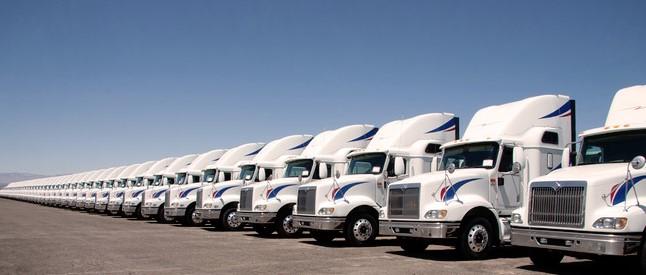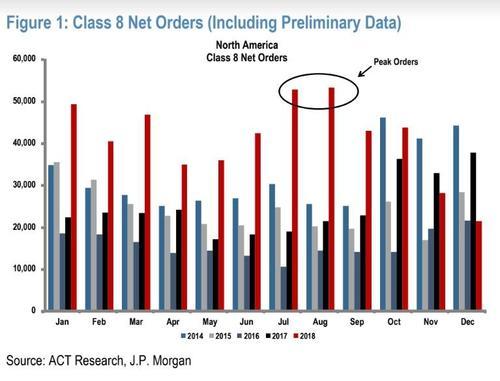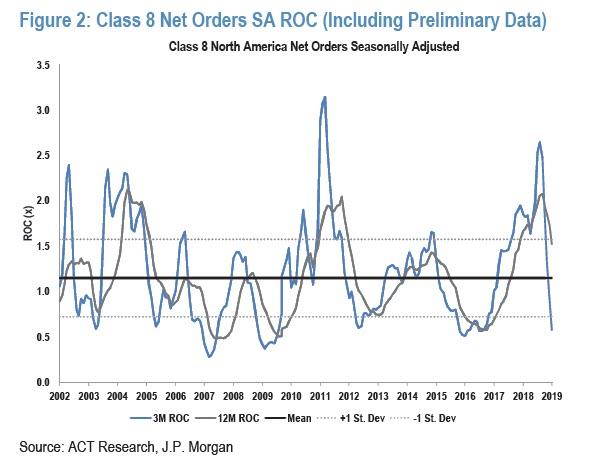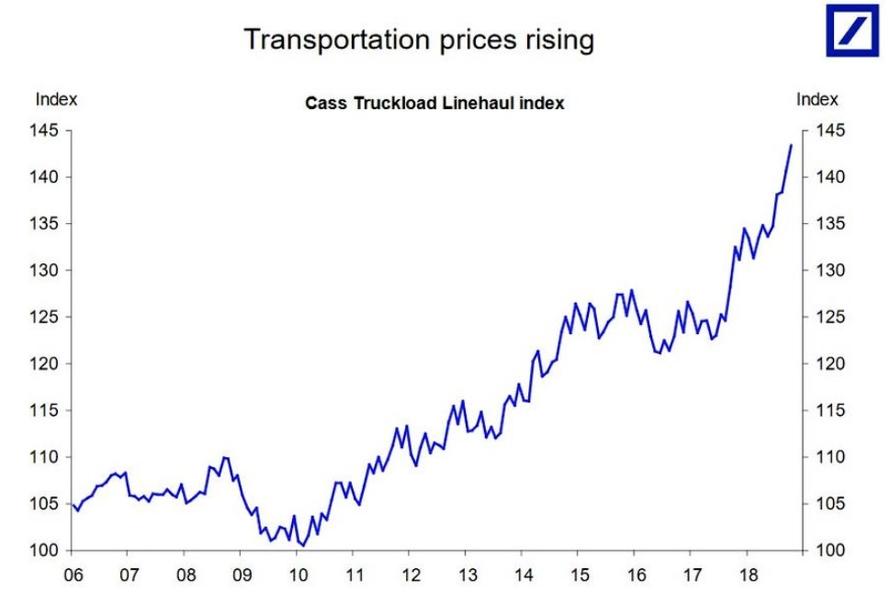1月にClass 8の大型トラック発注が68%急落
Among the latest dismal news about the strength of the US economy, on
Tuesday ACT Research released preliminary truck orders for January 2019
which showed that Class 8 truck orders collapsed an astounding 68% for
January. The decline is being attributed to a 300,000+ vehicle backlog potentially prompting fleets to halt purchases in the near term.
米国経済に関し最近憂鬱なニュースが多い中で、火曜にACT researchが2019年1月のトラック発注を開示した、1月にClass 8のトラック発注がなんと68%も急落した。この発注減は短期的に300,000台超の潜在在庫を生み出す。

Specifically, in January Class 8 net orders were 15,800 units (14,700 SA; 176,400 SAAR), down 68% YoY and down 26% MoM. Class 5- 7 January net orders were 23,400 units, down 24% YoY but up 3% MoM.
特に、1月には、Class 8のネット発注は15,800台だった、YoYで68%下落、MoMで26%下落だ。Class 5-7に関しては1月のネットオーダーは23,400台でYoYで24%下落しかしMoMで3%増加。

Class 8 trucks are one of the more common heavy trucks on the road, used for transport, logistics and occasionally (some dump trucks) for industrial purposes. Typical 18 wheelers on the road are generally all Class 8 vehicles, and traditionally are seen as an accurate coincident indicator of trade and logistics trends in the economy.
Class 8は市中で見かける最も一般的な大型トラック、運輸、ロジスティックそして産業用にも利用される。道路よく見かけるタイヤ18本のトラックはどれもClass 8に属する、そして伝統的に経済活動における貿易やロジスティックトレンドとよく一致する指数とみなされている。

Stephen Volkmann of Jefferies told Bloomberg that the collapse "should not be a surprise, but is likely to feed the bears". He also guessed that upgrade demand could continue to "support high production through 2020". We'll believe that when we see it.
Jefferies社のStephen Volkmannはブルームバーグにこう答えた、「この急落は驚くものではない、しかしベア派が勢いづくだろう」。彼の推測では、「2020には生産増」で需要が増えるだろう。それを目の当たりにすれば信じることになるだろう。
According to Neil Frohnapple at Buckingham, January is the third month in a row of year over year declines after Q3 of 2018 proved to be better than expectations. Frohnapple told Bloomberg he was "a little surprised" that net orders for January came in at just ~16,000.
BuckinghamのNeil Frohnapple氏によると、1月で三月連続でYoY下落となった、一方2018Q3は予想よりも良好だった。Frohnappleはブルームバーグにこう述べた、「ちょっと驚いた」1月のネットオーダーがわずか16,000だったことに。
According to JPMorgan, the New Orders component of the ISM Manufacturing Index tends to be the best leading indicator of future freight trends and truck demand. Specifically, the year-over-year change in New Orders has historically led the year-over-year change in the Cass Freight Index (the bank's preferred broad-based indicator of freight trends) by 6-9 months. The ISM New Orders index was 58.2 in January, down 11.0% YoY but still well above 50. The Cass Freight Index was down 0.8% YoY in December (the latest month available).
JPMorganによると、ISM 製造業指数の新規オーダーを見るのが今後の輸送トラック需要を予想するのに最適だ。特に、新規オーダーのYoY変化は歴史的に見てCass Freight Index(広範囲の輸送トレンド指数)のYoYを6−9か月先行している。ISMの新規オーダー指数は1月に58.2だった、YoYで11.0%下落したがまだ50を超えている。Cass Freight Indexは12月にYoYで0.8%下落した(最新データ)。

Despite this latest collapse in the trucking market, ACT Research
commented: "Regarding Class 8, recall that January 2018 marked the point
at which orders went vertical. We view this January’s order softness as
having more to do with pulled-forward orders and a very large Class 8
backlog than with the current supply-demand balance. Softening freight
growth and strong Class 8 capacity additions suggest that the
supply-demand balance will become a story in 2019, but January seems a
premature start to that tale."
トラック市場の直近の急落はあったが、ACT Researchはこうコメントする:「Class 8に関しては、2018年1月のは発注が急落した。私どもは、この1月の発注軟化は今後も続き、現在の需給バランスからして Class 8の在庫はとても増えるだろう。輸送量成長が軟化しClass 8の大きな輸送能力から2019の需給バランスが問題となりそうだ、1月がこの話の端緒と見える。」
This news comes on the back of a terrible December for heavy truck orders, which we discussed about last month, when we noted that the exponential surge in transportation prices as a result of an acute scarcity of truck drivers sent trucking prices soaring last year, and led to a historic spike in Class 8 truck orders as supply had scrambled to keep up with demand. That was, until November, when Class 8 orders started their precipitous drop.
今回のニュースは大型トラックに関する12月のひどい話に続くものだ、ZeroHedgeは先月もこのニュースを取り上げた、昨年はトラック運転手不足が深刻になり輸送費が急騰した、これがClass 8トラックの発注急増を生み出し需要に応じて供給を急増した。それも11月までの話で、Class 8トラックの発注は急落し始めた。

Back in December, BMO analyst Joel Tiss said that while "there is no doubt that freight and freight-rate growth have slowed, we do not think that it is time to panic just yet" after December's sharp 43% plunge.
12月に遡ると、BMOアナリストのJoel Tissはこう言った、「輸送量、輸送量成長が鈍化していることに疑いはないが、12月の急落を見てもまだパニックを起こすときではないと考えている」。
With January's collapse now in the books, we ask "how about now?"
いまや1月のデータが記録されているわけで、ZeroHedgeはもう一度問いただす「今はどういう感じでしょう?」
米国経済に関し最近憂鬱なニュースが多い中で、火曜にACT researchが2019年1月のトラック発注を開示した、1月にClass 8のトラック発注がなんと68%も急落した。この発注減は短期的に300,000台超の潜在在庫を生み出す。

Specifically, in January Class 8 net orders were 15,800 units (14,700 SA; 176,400 SAAR), down 68% YoY and down 26% MoM. Class 5- 7 January net orders were 23,400 units, down 24% YoY but up 3% MoM.
特に、1月には、Class 8のネット発注は15,800台だった、YoYで68%下落、MoMで26%下落だ。Class 5-7に関しては1月のネットオーダーは23,400台でYoYで24%下落しかしMoMで3%増加。

Class 8 trucks are one of the more common heavy trucks on the road, used for transport, logistics and occasionally (some dump trucks) for industrial purposes. Typical 18 wheelers on the road are generally all Class 8 vehicles, and traditionally are seen as an accurate coincident indicator of trade and logistics trends in the economy.
Class 8は市中で見かける最も一般的な大型トラック、運輸、ロジスティックそして産業用にも利用される。道路よく見かけるタイヤ18本のトラックはどれもClass 8に属する、そして伝統的に経済活動における貿易やロジスティックトレンドとよく一致する指数とみなされている。

Stephen Volkmann of Jefferies told Bloomberg that the collapse "should not be a surprise, but is likely to feed the bears". He also guessed that upgrade demand could continue to "support high production through 2020". We'll believe that when we see it.
Jefferies社のStephen Volkmannはブルームバーグにこう答えた、「この急落は驚くものではない、しかしベア派が勢いづくだろう」。彼の推測では、「2020には生産増」で需要が増えるだろう。それを目の当たりにすれば信じることになるだろう。
According to Neil Frohnapple at Buckingham, January is the third month in a row of year over year declines after Q3 of 2018 proved to be better than expectations. Frohnapple told Bloomberg he was "a little surprised" that net orders for January came in at just ~16,000.
BuckinghamのNeil Frohnapple氏によると、1月で三月連続でYoY下落となった、一方2018Q3は予想よりも良好だった。Frohnappleはブルームバーグにこう述べた、「ちょっと驚いた」1月のネットオーダーがわずか16,000だったことに。
According to JPMorgan, the New Orders component of the ISM Manufacturing Index tends to be the best leading indicator of future freight trends and truck demand. Specifically, the year-over-year change in New Orders has historically led the year-over-year change in the Cass Freight Index (the bank's preferred broad-based indicator of freight trends) by 6-9 months. The ISM New Orders index was 58.2 in January, down 11.0% YoY but still well above 50. The Cass Freight Index was down 0.8% YoY in December (the latest month available).
JPMorganによると、ISM 製造業指数の新規オーダーを見るのが今後の輸送トラック需要を予想するのに最適だ。特に、新規オーダーのYoY変化は歴史的に見てCass Freight Index(広範囲の輸送トレンド指数)のYoYを6−9か月先行している。ISMの新規オーダー指数は1月に58.2だった、YoYで11.0%下落したがまだ50を超えている。Cass Freight Indexは12月にYoYで0.8%下落した(最新データ)。

トラック市場の直近の急落はあったが、ACT Researchはこうコメントする:「Class 8に関しては、2018年1月のは発注が急落した。私どもは、この1月の発注軟化は今後も続き、現在の需給バランスからして Class 8の在庫はとても増えるだろう。輸送量成長が軟化しClass 8の大きな輸送能力から2019の需給バランスが問題となりそうだ、1月がこの話の端緒と見える。」
This news comes on the back of a terrible December for heavy truck orders, which we discussed about last month, when we noted that the exponential surge in transportation prices as a result of an acute scarcity of truck drivers sent trucking prices soaring last year, and led to a historic spike in Class 8 truck orders as supply had scrambled to keep up with demand. That was, until November, when Class 8 orders started their precipitous drop.
今回のニュースは大型トラックに関する12月のひどい話に続くものだ、ZeroHedgeは先月もこのニュースを取り上げた、昨年はトラック運転手不足が深刻になり輸送費が急騰した、これがClass 8トラックの発注急増を生み出し需要に応じて供給を急増した。それも11月までの話で、Class 8トラックの発注は急落し始めた。

Back in December, BMO analyst Joel Tiss said that while "there is no doubt that freight and freight-rate growth have slowed, we do not think that it is time to panic just yet" after December's sharp 43% plunge.
12月に遡ると、BMOアナリストのJoel Tissはこう言った、「輸送量、輸送量成長が鈍化していることに疑いはないが、12月の急落を見てもまだパニックを起こすときではないと考えている」。
With January's collapse now in the books, we ask "how about now?"
いまや1月のデータが記録されているわけで、ZeroHedgeはもう一度問いただす「今はどういう感じでしょう?」




